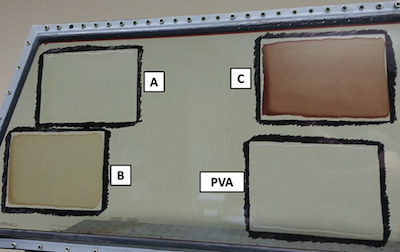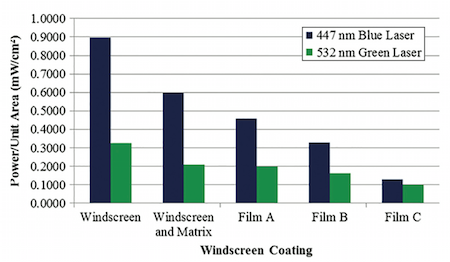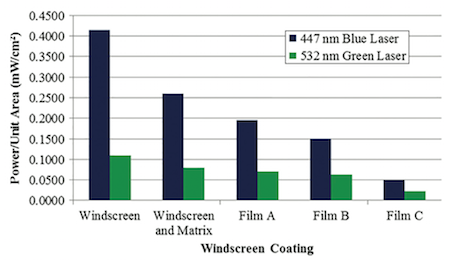Home
A comprehensive resource for safe and responsible laser use

2015 Nanocomposite coatings study
This paper was published online May 12 2015 in the Journal of Aviation Technology and Engineering, published by Perdue University Press.
Measuring the Effectiveness of Photoresponsive Nanocomposite Coatings on Aircraft Windshields to Mitigate Laser Intensity
Abstract
“In 2004, pilots reported 46 laser illumination events to the Federal Aviation Administration (FAA), with the number increasing to approximately 3,600 in 2011. Since that time, the number of reported laser incidents has ranged from 3,500 to 4,000. Previous studies indicate the potential for flight crewmember distraction from bright laser light being introduced to the cockpit.
“Compositional variations of the photoresponsive nanocomposite coatings were applied to an aircraft windscreen using a modified liquid dispersion/heating curing process. The attenuating effects of the deposited films on laser light intensity were evaluated using an optical power meter and the resultant laser intensity data through treated and untreated windscreens was collected.
“Data revealed a reduction in laser intensity (36–88%) in the presence of the engineered photoresponsive nanocomposite films. Results lend support of the view that the addition of transparent laser attenuating films applied to aircraft windscreens may improve flight safety, and reduce the risk from distraction or disruption of flight crewmembers’ vision.”
Authors
Ryan S. Phillips, Hubert K. Bilan, Zachary X. Widel, Randal J. DeMik, Samantha J. Brain, Matthew Moy, Charles Crowder, Stanley L. Harriman, James T. O’Malley III, Joseph E. Burlas, Steven F. Emmert, and Jason J. Keleher, all of Lewis University in Romeoville, Illinois.
Citation
Phillips, Ryan S.; Bilan, Hubert K.; Widel, Zachary X.; DeMik, Randal J.; Brain, Samantha J.; Moy, Matthew; Crowder, Charles; Harriman, Stanley L.; O'Malley, James T. III; Burlas, Joseph E.; Emmert, Steven F.; and Keleher, Jason J. (2015) "Measuring the Effectiveness of Photoresponsive Nanocompsite Coatings on Aircraft Windshields to Mitigate Laser Intensity," Journal of Aviation Technology and Engineering: Vol. 4: Iss. 2, Article 5. http://dx.doi.org/10.7771/2159-6670.1105
Summary (prepared by LaserPointerSafety.com)
Windscreen and coatings
The windscreen used in the study had been used on a Southwest Airlines Boeing 737 jet. Four coatings were developed by the Lewis University Chemistry Department and were applied to the windscreen, as shown:

The PVA coating had no nanoparticles, only the polyvinyl alcohol base solution that in coatings A, B and C included nanoparticles. Coating A was the thinnest (fewest nanoparticles) and C was the thickest.
From the photo, coatings B and C appear to reduce normal visibility. The paper does not give any information regarding the loss of light transmission across visible wavelengths.
Lasers
Two lasers were used, both emitting 20 milliwatts continuous wave (CW). One was a frequency-doubled Nd:YAG green at 532 nanometers. This is the most common color as it is seen in over 90% of all FAA-reported laser incidents. It has an FAA Visual Correction Factor of 0.88, meaning that to the human eye, this particular green appears 88% as bright as the brightest possible color (green-yellow light at 555 nanometers).
The other laser used a diode that emitted blue light at 447 nanometers. It has an FAA Visual Correction Factor of 0.03, meaning it appears 3% as bright as the brightest possible color. This also means that 20 mW of 532 nm green light would appear 88/3 or 29 times brighter to the human eye than 20 mW of 447 nm blue light.
Testing procedure and results
The lasers were tested at distances of 200 feet and 500 feet. The irradiance was measured through the windscreen alone, through the PVA-only coating, and through the three nanocomposite coatings A, B and C. Below are the results for the 200-foot distance.

Since both lasers emitted 20 mW of light, the blue laser clearly had lower divergence (a tighter beam) than the green laser. This is indicated by the fact that the blue laser’s irradiance was always higher (more power per unit area) than the green laser. (Remember that in this chart, the authors are simply measuring the lasers’ irradiance which is not affected by wavelengh, and so the apparent visual brightness is not a factor here.)
The PVA coating alone, with no nanocomposites, reduced the blue light from 0.9 mW/cm2 to 0.6 mW/cm2. Adding nanocomposites further reduced the light intensity.
Data from the 500-foot distance showed essentially identical trends, with the absolute amount of light reduced by about 1/2:

Eye damage and visual interference hazards
In the study, none of the measurements exceeded the Maximum Permissible Exposure limit of 2.54 mW/cm2 for an unintentional exposure less than 0.25 seconds. Thus, no potential eye injury would have occurred for this particular combination of laser power, divergence and distance.
The authors note that most measurements exceeded the FAA’s Sensitive Zone Exposure Limit of 0.1 mW/cm2 which could result in temporary flash blindness. However, they do not take into account the FAA’s Visual Correction Factor. The measurements for the green laser should be multiplied by 0.88 to indicate the actual visual effect of this light on pilots. Similarly, the measurements for the blue laser should be multiplied by 0.03 to indicate the actual visual effect. Doing so puts these measurements closer to, or below the SZEL.
(Of course, the main point of the study remains valid: that these coatings do help reduce the intensity of laser light.)
The authors indicated that their specific measurements were a “worst-case” scenario: “…the majority of laser illuminations occur within the critical flight zone as defined by the FAA that represent distances well beyond 500 feet…. This study was conducted at ranges well inside of these distances, and they represent a worst-case laser illumination scenario.”
Future research directions
The authors have suggestions for future research:
“This study supports the concept that the application of photoresponsive nanocomposite coatings may reduce the intensity of laser illumination incidents. Additional research should be conducted regarding the formulations of nanoparticle coatings to seek continued improvement and effectiveness of further reducing laser light intensity. Further testing is needed to measure the tint and potential effects of a pilot’s visual acuity and ability to recognize colors in the flight environment when photoselective coatings are utilized. Additional testing is also needed regarding the impact of environmental factors on the coatings, along with the longevity and durability of these coatings in the flight environment. Variables should include extreme temperature fluctuations both from internal (windscreen heat) and external (atmospheric) sources, ultraviolet (UV) exposure, and other external elements. Additional research is also needed regarding applying the appropriate method of laser mitigation to the flight deck environment. For example, should active means, such as placing protective eyewear be utilized, over passive means, such as applying coatings to the aircraft windscreens?”
From the Journal of Aviation Technology and Engineering